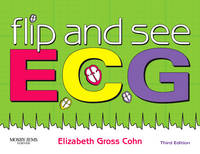
Flip and See ECG
Mosby (Verlag)
978-0-323-05586-4 (ISBN)
- Titel erscheint in neuer Auflage
- Artikel merken
When it comes to learning 3-lead ECG interpretation, there's simply no faster or easier way to master basic rhythms than this unique book. Using a fun and easy-to-understand writing style, it uses humor, cartoons, and personal stories to walk you through the entire ECG process - from finding a heartbeat, to monitoring an electrocardiogram, to interpreting the heart rhythm. In this title, a unique 'Flip and See' section allows you to view normal ECGs on one side of the page and abnormal ECGs on the other, along with concise text that clearly explains the differences between them. In addition, you'll find commonly asked questions and answers throughout the text.
Symbols Used in This Book How to Approach ECGs Tab 1: How the Heart Works The Heart Location Physiology (Function) Anatomy (Structure) Cardiac Cycle Summary Conduction Pathways Sinoatrial Node Atrioventricular Node Tab 2: The ECG The ECG Lead Placement and Vectors Reading ECGs: P-waves, QRS Complexes and T Waves - P Wave - P-R Interval - QRS Complex - ST Segment T Wave Tab 3: Introduction to the Rhythms Introduction to the Rhythms Naming Rhythms Normal Sinus Rhythm Sinus Arrhythmia Sinus Bradycardia Sinus Tachycardia Atrial Flutter Atrial Fibrillation Supraventricular Tachycardia Ventricular Tachycardia Torsades de Pointes Ventricular Fibrillation Asystole Heart Blocks - First Degree AV Heart Block Second Degree AV Heart Block, also known as Mobitz Type I (Wenckebach) Second Degree AV Heart Block, Also Known as Mobitz Type II Complete Heart Block (Third Degree) Artificial Pacemakers Tab 4: How to Interpret ECGs ECG Paper Normal ECG Calculating Rate Measuring ECG Waveforms ECG Calipers The Isoelectric Line Ectopic Activity - Premature Atrial Contraction Premature Junctional Contraction - Pemature Ventricular Contraction Summary Clues to Identifying Rhythms Tab 5: How to Use the Flip and See Portion of This Book Flip and See Guided Tutorial 1. normal 2. sinus arrhythmia 3. sinus bradycardia 4. sinus tachycardia 5. premature atrial contractions 6. premature ventricular contraction 7. atrial flutter 8. atrial fibrillation 9. supraventricular tachycardia 10. ventricular tachycardia 11. Torsades de Pointes 12. ventricular fibrillation 13. junctional or nodal rhythm 14. asystole 15. first degree heart block 16. second degree heart block, Mobitz type- I, or Wenckebach 17. second degree heart block, Mobitz type II 18. complete heart block 19. artificial pacemaker with capture - Heart Blocks - Look-alike Rhythms - Nonrhythms - Pulseless Electrical Activity Summary and a Few Golden Rules Tab 6: Rhythms Normal Sinus Rhythm Sinus Arrhythmia Sinus Bradycardia Sinus Tachycardia Premature Atrial Contractions Atrial Flutter Atrial Fibrillation Supraventricular Tachycardia Junctional (Nodal) Rhythm - Premature Ventricular Contractions Ventricular Tachycardia Torsades de Pointes Ventricular Fibrillation Asystole First Degree AV Heart Block Second Degree Heart Block Mobitz Type I (Wenckebach) Second Degree Heart Block Mobitz Type II Third Degree AV Heart Block: Complete Heart Block Pacemaker With 1:1 Capture Loose Lead/Cable Movement 60-Cycle Interference Junctional Rhythm With Rate of 40 Beats per Minute Normal Sinus Rhythm With Rate of 100 Beats per Minute Tab 7: Glossary Glossary
| Zusatzinfo | Approx. 150 illustrations |
|---|---|
| Verlagsort | St Louis |
| Sprache | englisch |
| Maße | 203 x 254 mm |
| Themenwelt | Medizinische Fachgebiete ► Innere Medizin ► Kardiologie / Angiologie |
| Medizin / Pharmazie ► Medizinische Fachgebiete ► Radiologie / Bildgebende Verfahren | |
| Studium ► 2. Studienabschnitt (Klinik) ► Anamnese / Körperliche Untersuchung | |
| ISBN-10 | 0-323-05586-9 / 0323055869 |
| ISBN-13 | 978-0-323-05586-4 / 9780323055864 |
| Zustand | Neuware |
| Haben Sie eine Frage zum Produkt? |
aus dem Bereich



